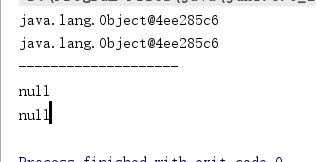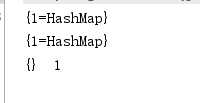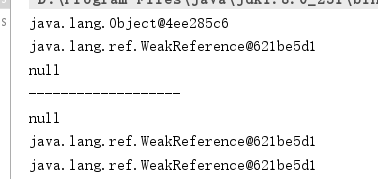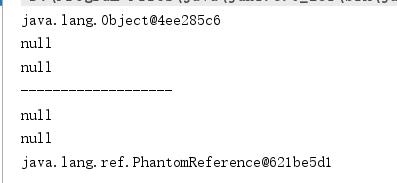JavaHigh04-强引用、弱引用、软引用、虚引用
本文共 4138 字,大约阅读时间需要 13 分钟。
目录
一、强引用
强引用只要有对象与其关联,gc时必定不会回收这个对象,如果内存不足,JVM会抛出OOM(OutOfMemory)错误也不会回收它。我们日常使用的大多数情况,基本上都是强引用
String str1 = new String("aa"); String str2 = str1; str1 = null;//置空 System.gc();; System.out.println(str1); System.out.println(str2); 二、软引用
软引用就是内存够用时不会回收,但内存不够时会回收。
内存够用的情况下:public void softRef(){ Object obj1 = new Object(); SoftReference 内存不够用的情况下:
配置内存为5M -Xms5m -Xms5m -XX:+PrintGCDetailspublic void softRefNotRnoughMemory(){ Object obj1 = new Object(); SoftReference 三、弱引用
弱引用在gc时,不管内存够不够用,都会被回收掉
//弱引用,只要有gc,统统回收掉 public void weakRef(){ Object obj1 = new Object(); WeakReference 
案例:某个应用读取大量的本地图片,如果每次都从磁盘读取则会严重影响性能,一次性全部加载内存又可能造成内存溢出,使用软引用可以解决这个问题
思路:用一个HashMap保存图片的路径和相应图片对象关联的软引用或弱引用之间的映射关系,内存不足时自动回收,即可避免OOM问题。 Map<String,SoftReference> imageCache = new HashMap<String,SoftReference>();WeakHashMap在做缓存时常用,以下是案例:
正常的HashMappublic void myHashMap(){ HashMap map = new HashMap<>(); Integer key = new Integer(1); String value = "HashMap"; map.put(key,value); System.out.println(map); key =null;//这个key和hashMap的key没有关系 System.out.println(map); System.gc(); System.out.println(map+"\t"+map.size()); } 
弱引用HashMap,当value为空时,不会阻止被回收,其他基本上一样
public void myWeakHashMap(){ WeakHashMap map = new WeakHashMap<>(); Integer key = new Integer(1); String value = "HashMap"; map.put(key,value); System.out.println(map); key =null;//这个key和hashMap的key没有关系 System.out.println(map); System.gc(); System.out.println(map+"\t"+map.size()); } 
四、虚引用
顾名思义,虚引用,就是引用形态虚设,在任何时候都可能会被gc回收,不能单独使用,也不能通过它访问对象,必须和ReferenceQueue引用队列联合使用。在被回收之前,要被队列保存一下
使用场景:在这个对象被收集器回收的时候收到一个系统通知或者后续添加进一步的处理(死刑之前做点什么,作为最后的价值) 先介绍下引用队列的使用:public void virtualRef() throws InterruptedException { Object obj1 = new Object(); ReferenceQueue 
虚引用
public void phantomRef() throws InterruptedException { Object obj1 = new Object(); ReferenceQueue referenceQueue = new ReferenceQueue<>(); PhantomReference phantomReference = new PhantomReference<>(obj1, referenceQueue); System.out.println(obj1); System.out.println(phantomReference.get()); System.out.println(referenceQueue.poll()); System.out.println("-------------------"); obj1 = null; System.gc(); Thread.sleep(500); System.out.println(obj1); System.out.println(phantomReference.get()); System.out.println(referenceQueue.poll()); } 
转载地址:http://cgmb.baihongyu.com/
你可能感兴趣的文章
MySQL8找不到my.ini配置文件以及报sql_mode=only_full_group_by解决方案
查看>>
mysql8的安装与卸载
查看>>
mysqlbinlog报错unknown variable ‘default-character-set=utf8mb4‘
查看>>
mysqldump 导出中文乱码
查看>>
mysqldump备份时忽略某些表
查看>>
mysqldump实现数据备份及灾难恢复
查看>>
mysqlreport分析工具详解
查看>>
MySQL一个表A中多个字段关联了表B的ID,如何关联查询?
查看>>
MYSQL一直显示正在启动
查看>>
MySQL一站到底!华为首发MySQL进阶宝典,基础+优化+源码+架构+实战五飞
查看>>
MySQL万字总结!超详细!
查看>>
Mysql下载以及安装(新手入门,超详细)
查看>>
MySQL中B+Tree索引原理
查看>>
mysql中cast() 和convert()的用法讲解
查看>>
mysql中floor函数的作用是什么?
查看>>
MySQL中group by 与 order by 一起使用排序问题
查看>>
mysql中having的用法
查看>>
MySQL中interactive_timeout和wait_timeout的区别
查看>>
mysql中int、bigint、smallint 和 tinyint的区别、char和varchar的区别详细介绍
查看>>
mysql中json_extract的使用方法
查看>>